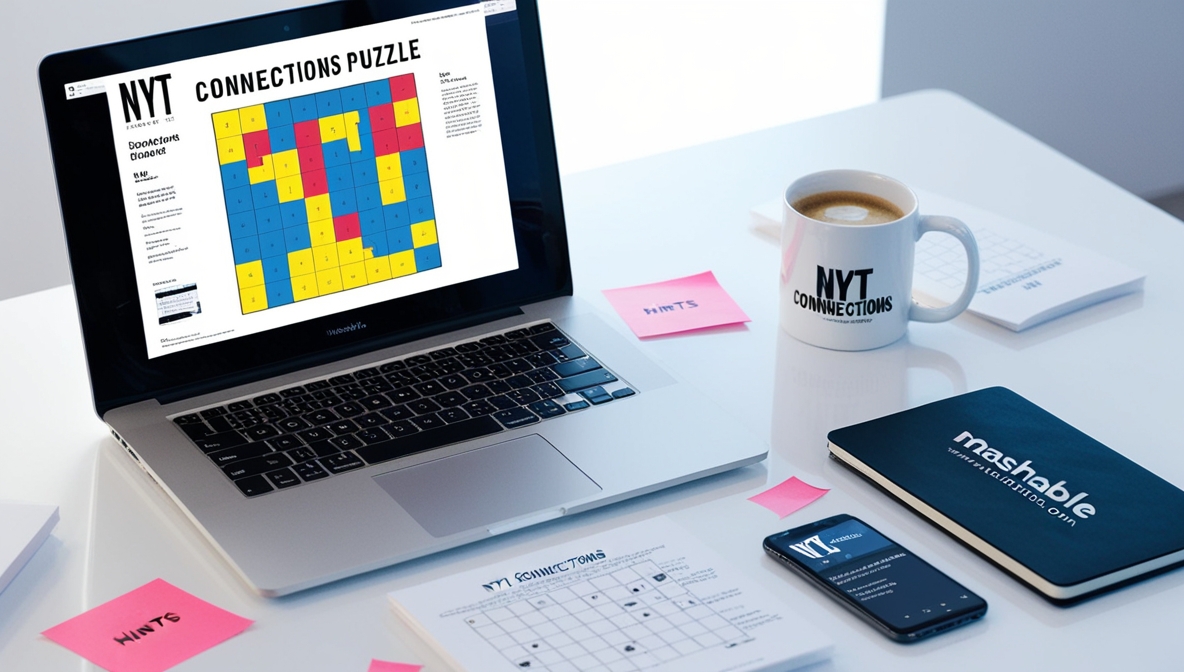Mashable NYT Connections Hints have become a go to solution for puzzle lovers trying to crack the challenging NYT Connections grid. Every morning, players across the United States look for the best connections hint today to avoid red herrings and identify hidden word associations. These hints offer a smart mix of category clues, tiered hints, and even disambiguation hints, making them essential for solving tricky groups especially the 🟪 purple ones. Unlike generic answer dumps, Mashable NYT Connections Hints use a ladder style hint system that improves your puzzle solving strategies over time. From casual players to puzzle pros, they’ve changed how the NYT puzzle help game is played every single day.
Why NYT Connections Has Everyone in a Mental Chokehold
When you sit down in the morning with your coffee and open the NYT Connections grid, you’re entering a world of challenge that seems simple but hides depth. It’s 16 words, grouped into four colour‑coded categories: 🟨 yellow, 🟩 green, 🟦 blue and 🟪 purple. The easiest group gives you a quick win, and by the time you hit the purple group you’re using lateral thinking, pattern detection and word association in ways you didn’t expect. The game hooks you because you feel smart when you nail the yellow, and you scratch your head when you hit the purple yet you still want to keep playing. In the United States the daily ritual catches on in homes, at breakfast tables, and even in group chats. For instance, your cousin in Iowa might send a screenshot of “one away” in the purple group, the retired English teacher in Kansas might sigh at a red‑herring word, and that quirky guy on Reddit will post about how Mashable’s NYT Connections hints saved his streak. The blend of simple mechanics and deep puzzle‑solving strategies makes this game more than a pastime it becomes part of your puzzle culture.
Mashable and the Rise of Hints as Puzzle Culture
It wasn’t long before the buzz around NYT Connections pushed the conversation beyond just “did you solve today’s grid?” to “what’s the best connections hint today?” That’s where Mashable stepped in. The site understood that players didn’t just want answers they wanted direction. So Mashable built a hint process: from category hints to pattern hints to partial answers. That kind of tiered help became part of the ritual. Online spaces like Reddit’s r/NYTConnections, Facebook puzzle groups, and Twitter threads started erupting each day. One post:
“Whenever I’m stuck I Google connections hint today and Mashable’s looks really helpful.” You’ll see folks saying “look at Mashable’s hint today before you throw the towel in.” The shift is real: hints became not just a cheat sheet but part of the solving strategy. Mashable’s NYT Connections hints now shape how players approach the puzzle, making the game more social, communal and strategy‑rich.
Puzzle Mechanics That’ll Mess With Your Brain (In a Good Way)
The mechanics of NYT Connections start simple: 16 words, four groups of four. But the devil’s in the details. You only get four wrong guesses. Each category has one word each in yellow, green, blue and purple difficulties. Because of that, you cannot just guess wildly. You need cognitive pattern recognition, phonetic nuance, idiomatic expression and word grouping skills. For example, you might think four words fit a theme of “sports teams”, but the real link is “brands named after sports teams” — a red herring. Here’s a look at how the colour‑coded categories tend to map out:
| Colour | Difficulty | What you’ll typically face |
|---|---|---|
| 🟨 Yellow | Easiest | Obvious group, everyday concept |
| 🟩 Green | Soft middle | Slightly abstract, may need extra step |
| 🟦 Blue | The swerve | Hidden connection, requires lateral thinking |
| 🟪 Purple | Scream into a pillow | Obscure wordplay, tricky red herrings |
This ladder approach forces you to warm up with yellow, apply more strategy in green and blue, and then dig deep for purple. The game isn’t just about knowing words: it’s about seeing relationships, recognising patterns and beating the grid before you blow all your lives.
🟨 Yellow: The “Oh Yeah, Duh” Group
The yellow group gives you your early win. You’ll often spot it quickly because the words feel familiar and the connection seems obvious. For example, the yellow might be four colours, four days of the week, four fruits something basic. By solving yellow fast, you gain momentum and confidence. Even though it’s easier, be mindful: some puzzle sets by editor Wyna Liu throw in a twist. You might think you’ve got the group, but one word subtly doesn’t fit. That’s where red herrings sneak in. So treat yellow as your launch pad: solve it quickly but stay alert.
🟩 Green: The Soft Middle
Once yellow’s done, green asks you to step up. The connection is still accessible, but it requires a mini‑jump: maybe a word pattern, maybe a less obvious theme. You’ll use word pattern hints or look for prefix/suffix clues without even realising it. That’s why you’ll see your friend in Iowa send “green group almost got me” while his boomer parent sighs at how “back in my day this would’ve been red”. Green is where you practice strategy: eliminate obvious fits, check if leftover words remain ambiguous, and ask yourself: “Could one of these belong elsewhere?” Use your mental tricks and you’ll clear green with less anxiety.
🟦 Blue: The Swerve
By the time you hit blue you’re into the “swerve zone”. The link might appear plausible at first but then you’ll realise the theme runs deeper or sideways. You’ll use partial answers or disambiguation hints to nudge your logic. For example, you might group four words under “car parts”, but actually they are “names of car models missing one letter”. That kind of angle is what blue often delivers. In that space you need mental flexibility, you’ll question your first instinct and you’ll benefit from thinking: “What if I’m looking at this the wrong way?” Avoid the trap of finishing blue just to get to purple. Take your time, use the hint types (we’ll detail them soon) and you’ll solve it more cleanly.
🟪 Purple: The Scream into a Pillow Group
This is where most players get stuck. Purple requires you to pull out all the stops: idiomatic expressions, phonetic nuance, lateral thinking, category clues that feel completely off at first. It’s the hardest difficulty tier. A boomer parent might glance at it and shrug. Meanwhile your cousin in Iowa is muttering under his breath because he’s one word away. Don’t rush purple. After yellow, green and blue you’ll have a smaller pool of words left and you can use that to identify oddities. Ask: is one word the only one with two syllables? Is one word a homophone? Do these form a phrase when combined? By treating purple as a puzzle within a puzzle, you’ll boost your overall solve rate and make those “aha!” moments richer.
NYT Connections Hint Types (Mashable’s Secret Sauce)
Category Hints
Category hints are broad strokes: they say something like “Think breakfast items” or “Words related to sports equipment”. They give you a theme without giving away the full answer. For Mashable’s NYT Connections hints, these are often your first nudge. They help you apply word association and connect four words under a plausible banner.
Word Pattern Hints
When the connection lies in spelling, sound or structure, you’ll see word pattern hints. These might mention prefixes, suffixes, rhymes or phonetic links. For example: “Words ending in –ing” or “Rhymes with ‘night’”. These hints draw on phonetic nuance and pattern detection rather than obvious meaning. They are especially useful for blue and purple groups.
Partial Answers
Partial answers reveal one or two correct words in a group. Mashable drops these when you’re stuck and need a foothold. They don’t spoil the entire group, so you still do the heavy lifting. A clever guess from that partial reveal can unlock the entire category. Use partial answers as a strategic boost, not a quit‑flag.
Complete Answers
Complete answers are full reveals: they show the entire set of four words and the category. Mashable offers them for players who decide to move on or study the solution. They function as learning tools. Study how the group was structured and you’ll improve your linguistic awareness for future grids.
Disambiguation Hints
Some words fit more than one possible theme. That’s where disambiguation hints appear: they clarify the context. Example: “Not the fruit – in this case it’s a brand name.” This form of hint helps you avoid red herrings and align your grouping logic correctly.
Hint Progression Strategy
Mashable uses a ladder approach: start with a vague hint, move to stronger clues, then partial answers, then full reveal. This tiered hints method supports players at different skill levels and preserves the solving experience. When you follow this progression you enhance your puzzle‑solving strategies and boost your confidence.
The Social Side: Why Connections Is More Than a Game
Playing NYT Connections turns into a daily communal activity. On Reddit, in r/NYTConnections, and across Twitter and Facebook puzzle fan pages you’ll find folks sharing screenshots, asking for connections hint today, or lamenting the purple group. A typical post:
“Still stuck on blue group. Anyone else checking Mashable’s NYT Connections hints forbes article?” The fact that so many players reference hint‑forums, share connections walkthroughs, and lean into collaborative learning transforms the game from solitary to social. Even that quirky guy on Reddit who ruthlessly critiques the puzzle creator becomes part of the conversation. And yes, the retired English teacher in Kansas and the boomer parent chiming in with “back in my day puzzles were easier” become part of your broader puzzle‑enthusiast tribe.
Mental Tricks for Mastering the Grid
You’ll build real skill if you apply these mental tricks. First, start by scanning all 16 words and pick out the ones that immediately scream “group”. Sometimes you’ll find an outlier word that doesn’t fit anything else that often points to the hardest group. Then you practise elimination: once you lock one group (often yellow), the remaining words shrink and patterns emerge faster. Another trick: say the words out loud or write them down. That engages your phonetic pattern detection. For example, you might hear a rhyme or notice a suffix or prefix that wasn’t obvious visually. Also take a break if you’re stuck. A short walk or coffee break gives your brain distance and helps with mental flexibility. Over time you’ll spot recurring themes, wordplay patterns and red herrings earlier. Your guessing strategy becomes sharper, your wins come quicker, and you’ll play each connections hint like a pro.
How Mashable’s Approach Changes the Game
What Mashable does differently is they treat hints like a layered experience rather than a simple answer dump. They craft each hint set, provide a visual hint map or breakdown sometimes, and help you reflect after the puzzle. Their approach supports growth: you don’t just solve one grid, you start learning how to think like a NYT Games puzzle creator. When you see how Wyna Liu constructs categories, you begin to recognise her style: subtle wordplay, misdirection, clever homophones. Then you stop being a passive solver and become an active thinker. Other sources might just post full answers or generic hints. Mashable’s hint sets integrate tiered hints, pattern recognition cues, and collaborative learning links. That means you absorb puzzle‑culture knowledge, get smarter, and solve more of today’s grid whether you’re in Iowa, Kansas or anywhere in the United States.
Creative Ways to Use and Deliver Your Hints
Don’t just passively read the hints. Use them creatively. For example, share the first category hint with friends and challenge them to guess the four words before you show the partial answers. Turn it into a social ritual: breakfast puzzle group with your cousin in Iowa, parent and boomer parent in Kansas, and that quirky guy on Reddit who always shows up. You can keep a connections journal track themes, colour‑coded categories, your guess times, hint types that helped you. You can even build DIY puzzles mimicking Mashable’s NYT Connections hints style: give a vague category, then a word pattern, then a partial answer. These creative uses make the puzzle more than a daily screen stare it becomes a mental game you share and improve at.
Final Thoughts
In the end, mastering the grid of NYT Connections is about more than just winning each day. It’s about sharpening your mind, training your logic, enjoying the daily ritual, and diving into puzzle culture. Mashable’s NYT Connections hints aren’t cheats they’re clever companions that help you level up. You’ll move from yellow wins to purple triumphs, and each step makes you smarter. So the next time you open the grid, take a breath, lean into the hint types, think laterally, say the words out loud, and remember: you’re not just solving a game you’re joining a playful, communal brain‑workout. Happy solving and may your next group of four land with a satisfying click.
Frequently Asked Questions
What is NYT Connections?
It’s a daily puzzle from the New York Times where you group 16 words into four themed sets of four.
Where can I find today’s connections hint today?
You can check Mashable’s site, social posts, or puzzle fan forums.
Are Mashable’s hints official?
No they’re independent, but trusted and widely used. Is it cheating to use hints?
Not at all. They’re learning aids, not shortcuts.
What’s the best strategy for solving Connections?
Start with the obvious (yellow), eliminate words, listen to patterns, then use hint progression if stuck.
What time does the puzzle update?
On the NYT Games app it refreshes around midnight local time.
Can I play past NYT Connections puzzles?
Yes archives exist via certain platforms though the daily fresh grid remains the main focus.
Why is the purple group always so hard?
Because it often uses obscure links, wordplay, idioms or lateral leaps. That’s the challenge by design.











